I was thinking about sampling last night around midnight when sleep wasn’t an option. Doesn’t everyone think about weaving when they can’t sleep? I started wondering if maybe the point of sampling, or at least some sampling, shouldn’t be project-focused but should instead be yarn-focused. I almost always sample before starting a project because I’ve been burned one too many times by projects that I thought would be great but turned out mediocre or worse. To sample, I pick my project type and yarn and then put on a short warp to check color interactions, weave structure, and sett. Most of my samples are between 10 and 24 inches long and perhaps 6 inches wide.

Kate Lange McKibben put on a warp of 8/2 cotton and wove honeycomb using Ra Ra Raffia to outline the cells for one of her samples in the March/April 2020 Yarn Lab. Photo by Matt Graves
I don’t know if I’ve ever looked at a yarn and just wondered how it could be used and then tried it in all sorts of setts and weave structures. Instead, I’ve made assumptions about new-to-me yarns that may or may not have been correct. When you think about it, that’s really the genius behind Yarn Lab. (I didn’t come up with the idea for Yarn Lab, so I think I can say that.) For a Yarn Lab, we ask a weaver to concentrate on one or two yarns, try them in a variety of weave structures and different setts, and then report on what they learned. Those reports include things such as the fabrics’ drape, appropriate setts for various structures, texture, and my favorite part, ideas for using the sample fabrics.
I was recently emailing with Christine Jablonski about the Yarn Lab she is working on for Handwoven September/October 2022. She had woven a few samples using Array wool, one of Gist’s yarns. She said she found the experience fun and that she was “getting very particular about her sampling.” I think she’s on to something. Sampling a yarn just for the sake of sampling has merit, and doing it well adds to the enjoyment.

These are just a few of the cones and balls in my stash that either aren’t labeled or contain yarns that are unfamiliar to me. Photo by Susan E. Horton
I’m currently sampling in my usual fashion for color and sett on a turned twill draft with 8/2 cotton. But this time when I finish sampling, instead of immediately jumping into the project, I’m going to tie on one of the lesser-known yarns in my stash just to see what happens. I can sample for plain weave and twill and change setts at will. And just like a Yarn Lab, I’m going to write up my results for future Susan. If I do this every time I sample, I may be able to finally put some of those unknown yarns to work. Yarn-based sampling just might become my new thing.
Weave well,
Susan

